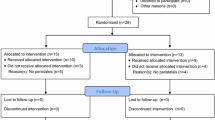Abstract
Background
Endoscopic retrograde cholangiopancreatography (ERCP) is commonly used in both the diagnosis and the treatment of biliary and pancreatic disorders. The aim of this study is to evaluate the effects of OB usage during ERCP on duodenal motility, the tolerability of the procedure (by patients) and the difficulty of the procedure (by the endoscopist).
Method
The study was conducted in Konya Training and Research Hospital General Surgery Endoscopy Unit in randomized prospective pattern. The patients were divided into the two groups as spasmolytic and control groups. The procedure was performed under topical anesthesia and sedation.
Results
There were 100 cases included into the study (50 cases in each group). The mean duodenal motility score was found to be 1.9 ± 0.5 in the study group and 3 ± 0.6 in the control group. In the study group, the tolerability of the procedure score by the endoscopist was moderate in 16 % and well/very well in 78 % of the cases. On the other hand, in the control group, the scores were poor in 21 %, moderate in 71 %, and well/very well in 24 % of the cases. In terms of patient satisfaction, in study group 42 % of the cases reported the procedure as moderate and 58 % reported as well/very well. However, in the control group 16 % of the cases reported the procedure as poor, 58 % moderate, and 26 % as well/very well.
Conclusion
Otilonium bromide is a safe agent with low side effects. It can be used before the ERCP procedure to decrease the duodenal motility. It eases the procedure, moreover, it increases the patients’ satisfaction.


Similar content being viewed by others
References
Evangelista S (1999) Otilonium bromide: a Selective spasmolytic for the gastrointestinal tract. J Int Med Res 27:207–222
Strege PR, Evangelista S, Lyford GL, Sarr MG, Farrugıa G (2004) Otilonium bromide inhibits calcium entry through L-type calcium channels in human intestinal smooth muscle. Neurogastroenterol Motil 16:167–173
Spinelli A (2007) Irritable bowel syndrome. Clin Drug Investig 27(1):15–33
Battaglia G, Morselli-Labate AM, Camarri E, Francavilla A, De Marco F, Mastropaolo G, Naccarato R (1998) Otilonium bromide in irritable bowel syndrome: a double-blind, placebo-controlled, 15-week study. Aliment Pharmacol Ther 12(10):1003–1010
Lynch CR, Khandekar S, Lynch SM et al (2007) Sublingual L-hyoscyamine for duodenal antimotility during ERCP: a prospective randomized doubleblinded study. Gastrointest Endosc 66:748–752
Hannigan BF, Axon AT, Avery S et al (1982) Buscopan or glucagon for endoscopic cannulation of ampulla of vater? J R Soc Med 75:21–22
Yamamoto N, Nakai Y, Sasahira N, Hirano K, Tsujino T, Isayama H, Komatsu Y, Tada M, Yoshida H, Kawabe T, Hiki N, Kaminishi M, Kurosaka H, Omata M (2006) Efficacy of peppermint oil as an antispasmodic during endoscopic retrograde cholangiopancreatography. J Gastroenterol Hepatol 21(9):1394–1398
Sutton JA, Kilminster SG, Mould GP (1997) The clinical pharmacology of single doses of otilonium bromide in healthy volunteers. Eur J Clin Pharmacol 52(5):365–369
Lazzaroni M, Porro GB (2001) Preparation, premedication, and surveilance. Endoscopy 33(2):103–108
Bell GD (2000) Preparation, premedication, and surveillance. Endoscopy 32(2):92–100
Marshall JB, Patel M, Mahajan RJ, Early DS, King PD, Banerjee B (1999) Benefit of intravenous antispsamodic (hyoscyamine sulfate) as premedication for colonoscopy. Gastrointest Endosc 49:720–726
Gómez NA, León CJ, Gutiérrez J (1997) Use of spasmolytic agent otilonium bromide (spasmomen) in digestive endoscopy: a prospective study in 63 patients. Acta Gastroenterol Latinoam 27(3):123–125
Disclosures
Drs Ömer Karahan, Barış Sevinç, Ahmet Okuş, Serden Ay and Nergis Aksoy have no conflicts of interest and financial ties to disclose.
Author information
Authors and Affiliations
Corresponding author
Additional information
RCT registration ID: AEARCTR-0000429 (registration date: 04.07.2014). The full trial can be found at: http://www.socialscienceregistry.org/trials/429.
Rights and permissions
About this article
Cite this article
Karahan, Ö., Sevinç, B., Okuş, A. et al. Otilonium bromide as spasmolytic during endoscopic retrograde cholangiopancreatography. Surg Endosc 29, 2266–2269 (2015). https://doi.org/10.1007/s00464-014-3939-2
Received:
Accepted:
Published:
Issue Date:
DOI: https://doi.org/10.1007/s00464-014-3939-2




